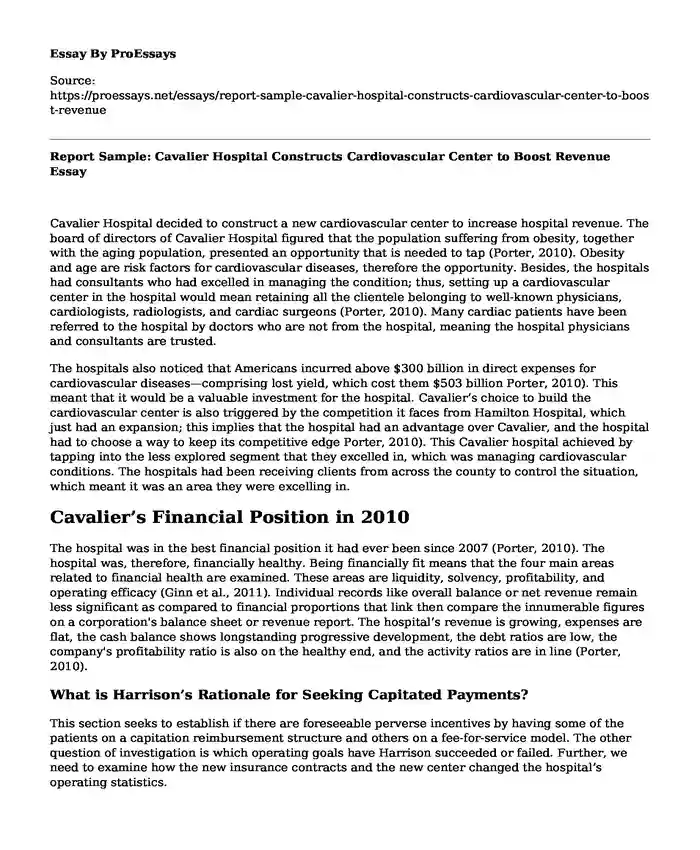Cavalier Hospital decided to construct a new cardiovascular center to increase hospital revenue. The board of directors of Cavalier Hospital figured that the population suffering from obesity, together with the aging population, presented an opportunity that is needed to tap (Porter, 2010). Obesity and age are risk factors for cardiovascular diseases, therefore the opportunity. Besides, the hospitals had consultants who had excelled in managing the condition; thus, setting up a cardiovascular center in the hospital would mean retaining all the clientele belonging to well-known physicians, cardiologists, radiologists, and cardiac surgeons (Porter, 2010). Many cardiac patients have been referred to the hospital by doctors who are not from the hospital, meaning the hospital physicians and consultants are trusted.
The hospitals also noticed that Americans incurred above $300 billion in direct expenses for cardiovascular diseases—comprising lost yield, which cost them $503 billion Porter, 2010). This meant that it would be a valuable investment for the hospital. Cavalier’s choice to build the cardiovascular center is also triggered by the competition it faces from Hamilton Hospital, which just had an expansion; this implies that the hospital had an advantage over Cavalier, and the hospital had to choose a way to keep its competitive edge Porter, 2010). This Cavalier hospital achieved by tapping into the less explored segment that they excelled in, which was managing cardiovascular conditions. The hospitals had been receiving clients from across the county to control the situation, which meant it was an area they were excelling in.
Cavalier’s Financial Position in 2010
The hospital was in the best financial position it had ever been since 2007 (Porter, 2010). The hospital was, therefore, financially healthy. Being financially fit means that the four main areas related to financial health are examined. These areas are liquidity, solvency, profitability, and operating efficacy (Ginn et al., 2011). Individual records like overall balance or net revenue remain less significant as compared to financial proportions that link then compare the innumerable figures on a corporation's balance sheet or revenue report. The hospital’s revenue is growing, expenses are flat, the cash balance shows longstanding progressive development, the debt ratios are low, the company's profitability ratio is also on the healthy end, and the activity ratios are in line (Porter, 2010).
What is Harrison’s Rationale for Seeking Capitated Payments?
This section seeks to establish if there are foreseeable perverse incentives by having some of the patients on a capitation reimbursement structure and others on a fee-for-service model. The other question of investigation is which operating goals have Harrison succeeded or failed. Further, we need to examine how the new insurance contracts and the new center changed the hospital’s operating statistics.
Capitation payments refer to overheads agreed on in a capitated agreement by a health cover corporation and a health provider (Porter, 2010). They remain stable, pre-planned monthly expenditures accepted by a doctor, health center, or hospital for each patient registered in a health proposal, or for each per capita(Porter, 2010). Harrison’s rationale for seeking capitated payments is offering bundled packages to health insurers. This will mean getting paid the same amount for the same medical condition. That way, it will not matter if the hospital chooses to use a nuclear stress test or a workout stress test for a particular patient since it does not charge the cover corporation for the test. It can go onward and utilize modern technology minus having to pursue cover endorsement every time since it does not charge the cover corporation or patient an additional amount if the hospital uses the gear(Porter, 2010). The hospital also gets compensated for supposing the patient's overall cardiac maintenance every year, provided the risk-attuned effects beat the nationwide means for results information(Porter, 2010). For those patients in the hospital’s capitation-founded bundles, Cavalier is yet to fail to meet any of those standards.
Should Harrison Advocate an Expansion of the Rotunda Model across all Specialties in the Hospital? If so, what Financial Trends should he Seek to Continue or Reverse in Implementing the New Model?
Yes, Harrison can advocate for the expansion of the Rotunda model in all specialties. The expansion will be seen as organizational growth which can offer small companies innumerable benefits, comprising of things such as grander efficacies ranging from economies of scale, augmented force, a grander capability to endure market variations, an augmented survival rate, grander revenues, and increased regard (Shen & Ginn, 2012). Its financial standing determines the company's method to expand with the opposition rather than even administration instruction. Several general development approaches incorporate comprise market infiltration, market development, product development, broadening, and procurement. The expansion using the hospital rotunda model will result in increased revenue, better profits, and better services. Harrison should be careful to continue observing financial trends such as artificial intelligence and blockchain technology.
References
Ginn, G. O., Shen, J. J., & Moseley, C. B. (2011). Hospital financial position and the adoption of electronic health records. Journal of Healthcare Management, 56(5), 337-352. https://doi.org/10.1097/00115514-201109000-00009
Porter, M. E. (2010). What is the value in health care? New England Journal of Medicine, 363(26), 2477-2481. https://doi.org/10.1056/nejmp1011024
Shen, J. J., & Ginn, G. O. (2012). Financial position and adoption of electronic health records: a retrospective longitudinal study. Journal of Health Care Finance, 38(3), 61. https://doi.org/10.1097/00115514-201109000-00009
Cite this page
Report Sample: Cavalier Hospital Constructs Cardiovascular Center to Boost Revenue. (2023, Nov 23). Retrieved from https://proessays.net/essays/report-sample-cavalier-hospital-constructs-cardiovascular-center-to-boost-revenue
If you are the original author of this essay and no longer wish to have it published on the ProEssays website, please click below to request its removal:
- The Elderly as a Vulnerable Population Essay
- Research Paper on Effective Ways to Prevent Cancer
- Perioperative Prophylaxis Paper Example
- Research Paper on Obesity as a Current Health Issue
- Paper Example on Healthy Eating in Busy Lifestyles - Tips from Joe Max
- Research Paper on Birth Control: Options for Fertility Control & Family Planning
- COVID-19 in Texas: Risk, Impact and Awareness - Essay Sample







